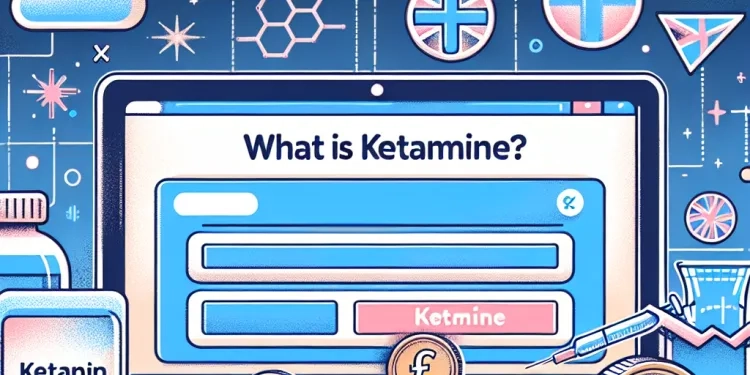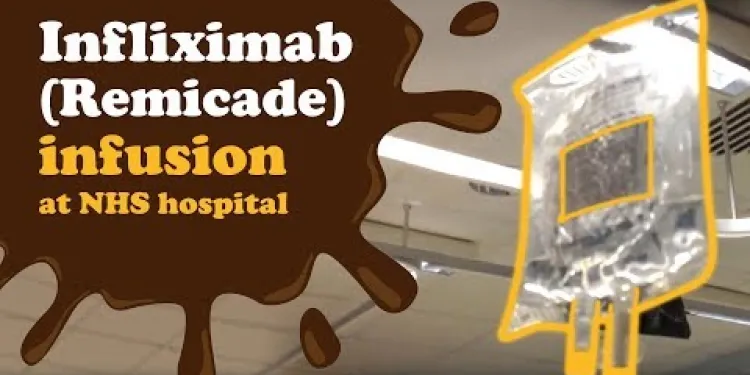
Find Help
More Items From Ergsy search
-

What is ketamine infusion therapy?
Relevance: 100%
-

How is ketamine administered?
Relevance: 68%
-

What should I expect during a ketamine infusion?
Relevance: 66%
-

What is Ketamine?
Relevance: 62%
-

What conditions is ketamine used to treat?
Relevance: 56%
-

How is ketamine different from traditional antidepressants?
Relevance: 54%
-

Is ketamine addictive?
Relevance: 54%
-

How does ketamine work?
Relevance: 54%
-

How long do the effects of ketamine last?
Relevance: 52%
-

Is ketamine legal?
Relevance: 50%
-

Is ketamine a controlled substance?
Relevance: 48%
-

Is ketamine safe for everyone?
Relevance: 48%
-

Infliximab infusion (Remicade) for Crohns Disease at Addenbrookes NHS hospital
Relevance: 45%
-

What are the common side effects of ketamine?
Relevance: 45%
-

Does ketamine have long-term effects?
Relevance: 45%
-

What is the difference between ketamine and esketamine?
Relevance: 44%
-

What precautions are necessary when using ketamine?
Relevance: 43%
-

How quickly can ketamine alleviate depression symptoms?
Relevance: 39%
-

Can I drive after having ketamine?
Relevance: 19%
-

What drugs are commonly used to spike drinks?
Relevance: 17%
-

Can ketamine be used to treat major depressive disorder?
Relevance: 16%
-

What forms does CBD come in?
Relevance: 14%
-

What effects do spiking drugs have on the body?
Relevance: 14%
-

What substances are commonly associated with drug offences?
Relevance: 13%
-

How long do the effects of a spiked drink last?
Relevance: 13%
-

Haemophilia
Relevance: 11%
-

How is CBD made?
Relevance: 10%
-

Can drink spiking cause long-term health effects?
Relevance: 10%
-

How effective are drink testing kits?
Relevance: 10%
-

How is spinal anaesthesia different from an epidural?
Relevance: 9%
-

Charlie and Rupert on their journey with Spinal Muscular Atrophy and Zolgensma Gene Therapy
Relevance: 9%
-

John Wesley: Faith That Sparked the Methodist Movement | Full Movie
Relevance: 8%
-

How are homeopathic medicines made?
Relevance: 7%
-

Pre chemotherapy Information Video
Relevance: 7%
-

How long does a blood transfusion take?
Relevance: 7%
-

How to stay cool during a heatwave
Relevance: 7%
-

What are the uses of cannabis extract?
Relevance: 7%
-

Can you ingest cannabis extract directly?
Relevance: 7%
-

Government Announces Funding Boost for Digital Health Innovations
Relevance: 7%
-

Can spiking happen with non-alcoholic drinks?
Relevance: 6%
Introduction to Ketamine Infusion
Ketamine infusion is a medical procedure primarily used for pain management and treatment-resistant depression in the UK. This innovative therapy has gained popularity due to its potential to provide rapid relief for patients who have not responded well to traditional treatments. Understanding what to expect during a ketamine infusion can help ease apprehension and prepare you for the experience.
Preparation Before the Infusion
Before your scheduled ketamine infusion, it is essential to consult with your healthcare provider to discuss your medical history and any medications you are currently taking. You'll be advised to avoid eating for a few hours before the procedure to minimize the risk of nausea. It's also recommended to arrange for someone to accompany you to and from the appointment, as you may feel groggy afterwards.
The Ketamine Infusion Procedure
On the day of the infusion, you'll be brought into a comfortable room, where a healthcare professional will review the procedure with you. Ketamine is delivered intravenously, so an IV will be inserted into your arm or hand. The infusion typically lasts 45 minutes to an hour. The staff will monitor your vital signs throughout the process to ensure your safety and comfort.
What You May Experience During the Infusion
During the ketamine infusion, you may experience a variety of sensations. Some people report feelings of dissociation, mild euphoria, or altered perception, which are common due to ketamine's psychedelic properties. It's important to remain calm and remember that these sensations are temporary and tend to dissipate once the infusion is complete.
Post-Infusion Recovery
After the infusion, you will be monitored for a short period to ensure you do not experience any adverse effects. It is common to feel tired or a bit disoriented, so resting for the remainder of the day is advisable. Your healthcare provider may provide guidance on how to manage any lingering effects and will answer any questions you may have.
Potential Side Effects
While ketamine infusions are generally well-tolerated, there are potential side effects. These can include dizziness, nausea, increased heart rate, or mild hallucinations. These side effects are typically short-lived. Always communicate with your healthcare provider if any side effect becomes concerning or persists.
Conclusion
Ketamine infusion therapy presents a promising option for those with treatment-resistant conditions. By understanding what to expect during the process, patients can approach their infusions with confidence and a clearer idea of the potential outcomes. Always maintain open communication with your healthcare provider to ensure the best possible experience and results.
Introduction to Ketamine Infusion
Ketamine infusion is a special medical treatment used in the UK. It helps people who have a lot of pain or depression that other treatments don't help. This treatment is getting more popular because it can help people feel better quickly. Knowing what happens during a ketamine infusion can make you feel less worried and ready for the treatment.
Preparation Before the Infusion
Before your ketamine infusion, talk to your doctor. Tell them about your health and any medicine you take. They will tell you not to eat for a few hours before the infusion so you don't feel sick. It's a good idea to have someone come with you to the appointment, as you might feel sleepy afterward.
The Ketamine Infusion Procedure
On the day of your infusion, you will sit in a comfy room. A healthcare person will explain what will happen. You will get ketamine through a small tube in your arm or hand. This takes about 45 minutes to an hour. The staff will check your health the whole time to make sure you are safe and feel okay.
What You May Experience During the Infusion
During the infusion, you might feel different things. Some people feel like they're in a dream or very happy. They might see or feel things differently because of the ketamine. Remember, these feelings are normal and will go away when the infusion is finished.
Post-Infusion Recovery
After the infusion, you will rest for a little while. This is to make sure you are feeling okay. It's normal to feel tired or a bit confused, so it's best to relax for the rest of the day. Your doctor will tell you how to take care of yourself and answer any questions you have.
Potential Side Effects
Most people don't have problems with ketamine infusions, but sometimes there are side effects. These can include feeling dizzy, feeling sick, a faster heartbeat, or seeing things that aren't there. Usually, these go away quickly. Tell your doctor if anything worries you or doesn't go away.
Conclusion
Ketamine infusion therapy can help people when other treatments don't work. Knowing what to expect can help you feel more confident about the treatment. Always talk openly with your doctor to have the best experience and results.
Frequently Asked Questions
Useful Links
- Ergsy carfully checks the information in the videos we provide here.
- Videos shown by Youtube after a video has completed, have NOT been reviewed by ERGSY.
- To view, click the arrow in centre of video.
- Most of the videos you find here will have subtitles and/or closed captions available.
- You may need to turn these on, and choose your preferred language.
- Go to the video you'd like to watch.
- If closed captions (CC) are available, settings will be visible on the bottom right of the video player.
- To turn on Captions, click settings .
- To turn off Captions, click settings again.
More Items From Ergsy search
-

What is ketamine infusion therapy?
Relevance: 100%
-

How is ketamine administered?
Relevance: 68%
-

What should I expect during a ketamine infusion?
Relevance: 66%
-

What is Ketamine?
Relevance: 62%
-

What conditions is ketamine used to treat?
Relevance: 56%
-

How is ketamine different from traditional antidepressants?
Relevance: 54%
-

Is ketamine addictive?
Relevance: 54%
-

How does ketamine work?
Relevance: 54%
-

How long do the effects of ketamine last?
Relevance: 52%
-

Is ketamine legal?
Relevance: 50%
-

Is ketamine a controlled substance?
Relevance: 48%
-

Is ketamine safe for everyone?
Relevance: 48%
-

Infliximab infusion (Remicade) for Crohns Disease at Addenbrookes NHS hospital
Relevance: 45%
-

What are the common side effects of ketamine?
Relevance: 45%
-

Does ketamine have long-term effects?
Relevance: 45%
-

What is the difference between ketamine and esketamine?
Relevance: 44%
-

What precautions are necessary when using ketamine?
Relevance: 43%
-

How quickly can ketamine alleviate depression symptoms?
Relevance: 39%
-

Can I drive after having ketamine?
Relevance: 19%
-

What drugs are commonly used to spike drinks?
Relevance: 17%
-

Can ketamine be used to treat major depressive disorder?
Relevance: 16%
-

What forms does CBD come in?
Relevance: 14%
-

What effects do spiking drugs have on the body?
Relevance: 14%
-

What substances are commonly associated with drug offences?
Relevance: 13%
-

How long do the effects of a spiked drink last?
Relevance: 13%
-

Haemophilia
Relevance: 11%
-

How is CBD made?
Relevance: 10%
-

Can drink spiking cause long-term health effects?
Relevance: 10%
-

How effective are drink testing kits?
Relevance: 10%
-

How is spinal anaesthesia different from an epidural?
Relevance: 9%
-

Charlie and Rupert on their journey with Spinal Muscular Atrophy and Zolgensma Gene Therapy
Relevance: 9%
-

John Wesley: Faith That Sparked the Methodist Movement | Full Movie
Relevance: 8%
-

How are homeopathic medicines made?
Relevance: 7%
-

Pre chemotherapy Information Video
Relevance: 7%
-

How long does a blood transfusion take?
Relevance: 7%
-

How to stay cool during a heatwave
Relevance: 7%
-

What are the uses of cannabis extract?
Relevance: 7%
-

Can you ingest cannabis extract directly?
Relevance: 7%
-

Government Announces Funding Boost for Digital Health Innovations
Relevance: 7%
-

Can spiking happen with non-alcoholic drinks?
Relevance: 6%


